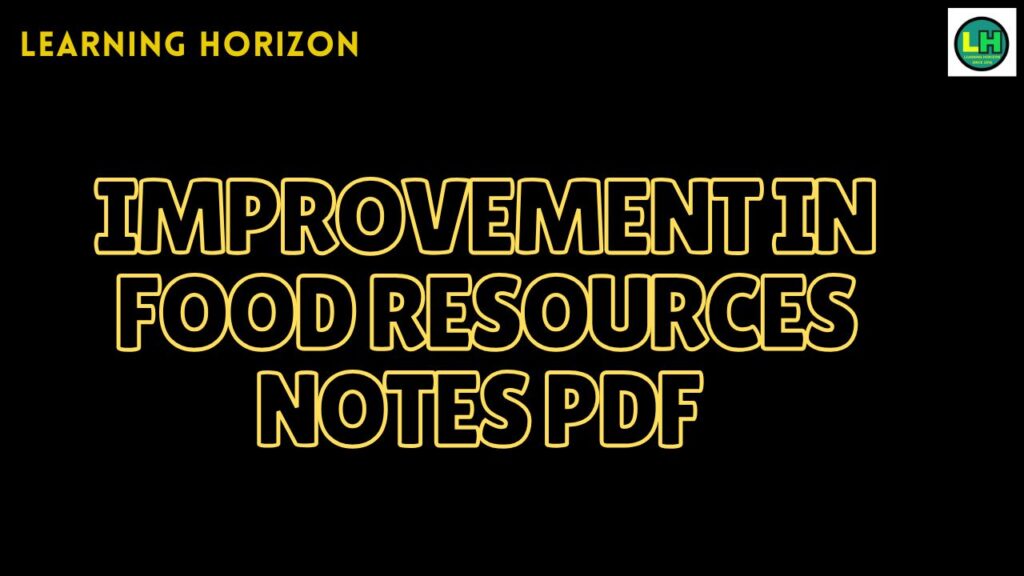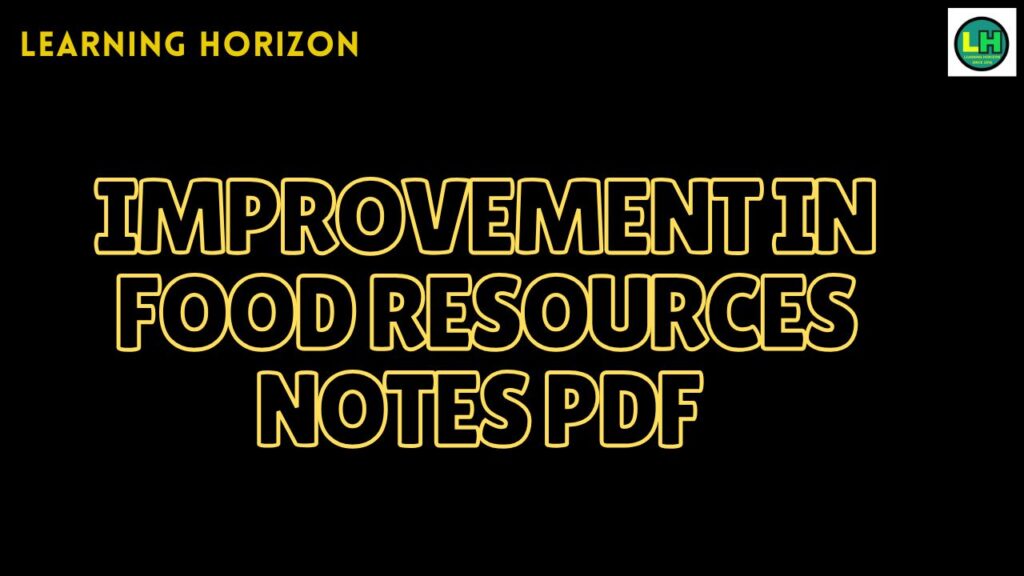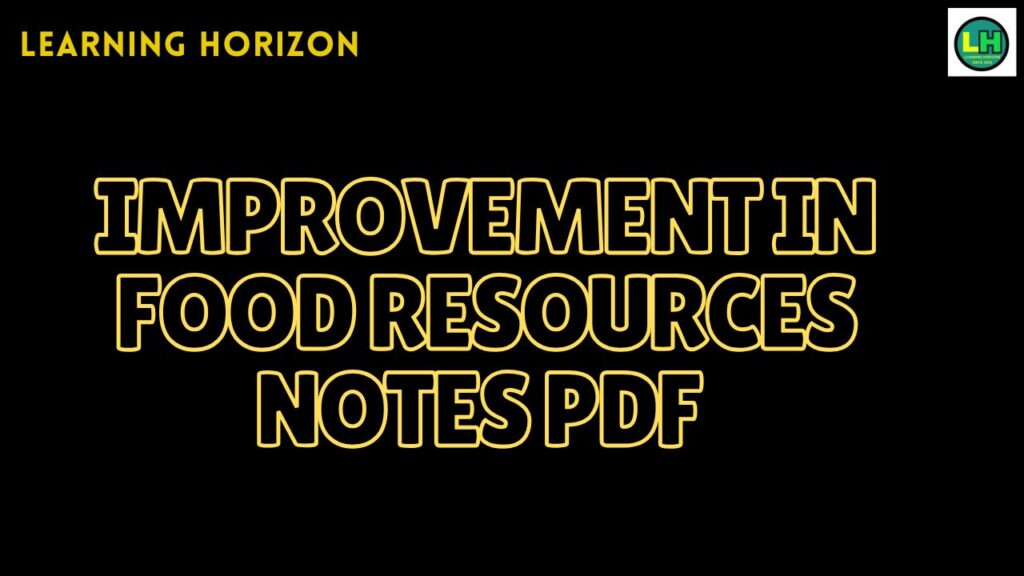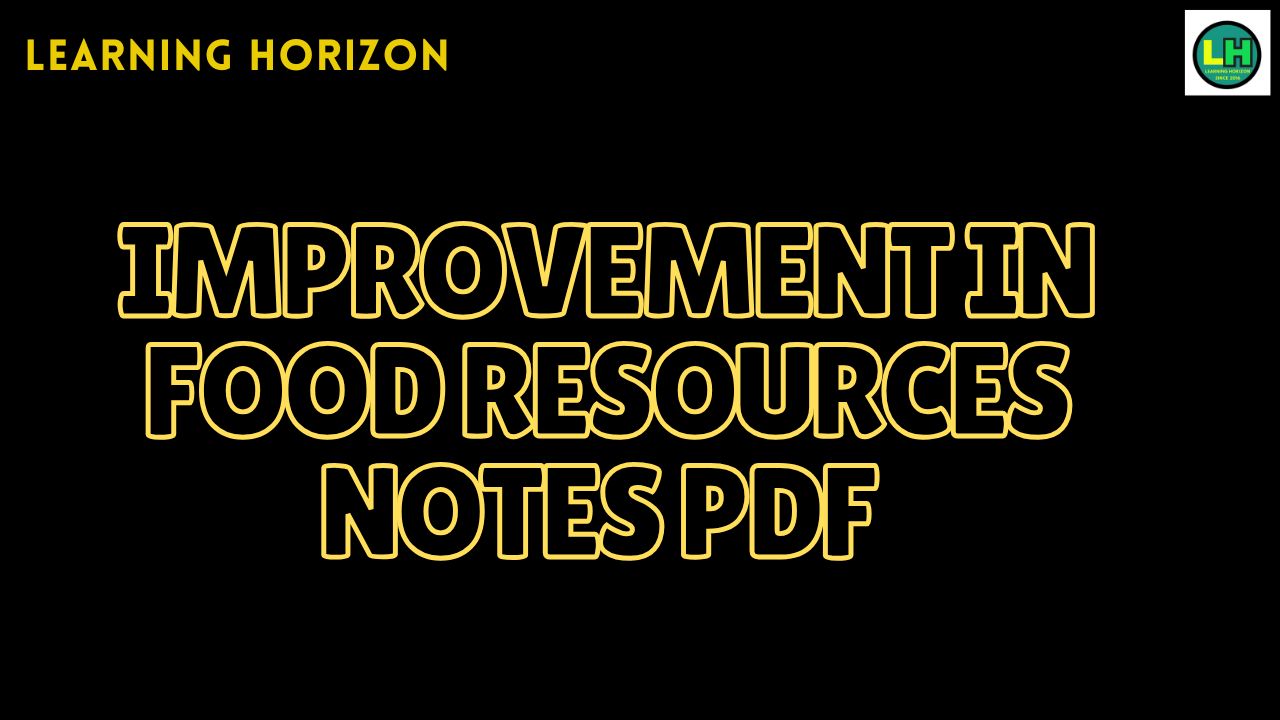
Improvement in food resources notes pdf
Why Is Improvement Needed?
- Population Growth: India has over 1 billion people and needs more than 250 million tonnes of grain annually.
- Limited Land: Most cultivable land is already in use—no scope to expand cultivation.
- Need for Higher Efficiency: Must increase production per unit area.
- Environmental Concerns: Overuse of natural resources harms the environment.
- Malnutrition & Hunger: Simply producing more food is not enough—access and affordability are also key.
- Sustainable Farming: Combine crop production with livestock, poultry, fisheries, bee-keeping, etc.
Main Areas of Food Improvement
1. Improvement in Crop Yields
- Cereals: Carbohydrates (e.g. rice, wheat)
- Pulses: Proteins (e.g. gram, moong)
- Oilseeds: Fats (e.g. soybean, mustard)
- Fruits & Vegetables: Vitamins & minerals
- Fodder Crops: Livestock feed
2. Crop Variety Improvement
Achieved by:
- Hybridisation: Crossing different types of plants (varieties, species, or genera)
- Genetic modification (GM crops)
Improvement factors:
- Higher yield
- Better quality (e.g. protein in pulses, oil in seeds)
- Biotic resistance (pests, diseases)
- Abiotic resistance (drought, salinity, temperature)
- Short maturity duration (multiple crops per year)
- Wider adaptability (different regions, climates)
- Desirable traits (e.g. dwarf wheat, tall fodder crops)
✅ Answers to Key Questions
📌 Q1. What do we get from cereals, pulses, fruits, and vegetables?
- Cereals: Carbohydrates
- Pulses: Proteins
- Oilseeds: Fats
- Fruits & Vegetables: Vitamins and minerals
Q2. How do biotic and abiotic factors affect crop production?
- Biotic factors: Diseases, insects, nematodes—can destroy crops.
- Abiotic factors: Drought, flood, salinity, heat—can reduce yield or destroy entire crops.
Q3. What are desirable agronomic characteristics for crop improvement?
- Cereals: Dwarf varieties (use fewer nutrients, resist lodging)
- Fodder crops: Tall with profuse branching (more biomass)
- Others: Short duration, uniform maturity, high nutrient content
Crop Production Management
➤ Types of Farming Practices:
- No-cost (minimal investment)
- Low-cost
- High-cost (uses modern technology, machinery, fertilizers)
➤ (i) Nutrient Management
Plants get nutrients from:
- Air: Carbon, oxygen
- Water: Hydrogen
- Soil: Macronutrients & micronutrients
Q4. What are macronutrients and why are they called macronutrients?
- Nutrients required in large amounts
- E.g., Nitrogen, Phosphorus, Potassium, Calcium, Magnesium, Sulphur
Q5. How do plants get nutrients?
- Air: Carbon and oxygen
- Water: Hydrogen
- Soil: Remaining 13 essential nutrients (macro and micro)
Manure and Fertilizers
➤ Manure
- Organic matter, improves soil structure and fertility
- Made from decomposed plant/animal waste
Types:
- Compost: Decomposed farm/domestic waste
- Vermi-compost: Uses earthworms
- Green manure: Crops like sun hemp grown and ploughed into soil
➤ Fertilizers
- Commercially produced nutrients
- Provide NPK (Nitrogen, Phosphorus, Potassium)
- Can improve growth but:
- Risk of soil degradation with overuse
- Can cause water pollution
Improvement in food resources notes pdf : class 9 science top notes bilingual
Question 1: What are macronutrients and why are they called macronutrients?
Answer:
Macronutrients are the nutrients that plants require in large quantities for their growth and development.
These include:
- Nitrogen (N)
- Phosphorus (P)
- Potassium (K)
- Calcium (Ca)
- Magnesium (Mg)
- Sulphur (S)
They are called “macro” nutrients because they are essential in large amounts for the proper growth of plants.
Question 2: How do plants get nutrients?
Answer:
Plants obtain nutrients from three main sources:
- Air:
- Carbon (C)
- Oxygen (O)
- Water:
- Hydrogen (H)
- Soil:
- The remaining 13 essential nutrients (both macro and micronutrients)
Improvement in food resources notes pdf : class 9 science top notes bilingual
Manure
● Definition:
Manure is made from organic matter, usually plant and animal waste. It contains a good amount of organic material and small quantities of nutrients.
● Benefits of Manure:
- Increases soil fertility
- Improves soil structure
- Increases water holding capacity in sandy soils
- Improves drainage in clayey soils
- Recycles biological (organic) farm waste
- Reduces dependence on chemical fertilizers, helping protect the environment
● Types of Manure:
- Compost and Vermi-compost
- Compost: Made by decomposing farm waste (like cow dung, vegetable peels, leaves, etc.) in pits.
- Vermi-compost: Made by using earthworms to speed up the decomposition process.
- Green Manure
- Certain plants (like sun hemp or guar) are grown before the main crop and then ploughed into the soil.
- This enriches the soil with nitrogen and phosphorus.
Fertilizers
● Definition:
Fertilizers are commercially produced chemical nutrients supplied to plants. They primarily provide:
- Nitrogen (N)
- Phosphorus (P)
- Potassium (K) → also known as NPK
● Advantages:
- Promote rapid vegetative growth
- Help in achieving higher yields
● Disadvantages / Precautions:
Overuse or improper use of fertilizers can lead to:
- Nutrients not fully absorbed by plants
- Water pollution (if washed into rivers or lakes)
- Decreased soil fertility over time
- Harm to beneficial soil microorganisms
Question 1: Compare the use of manure and fertilizers in maintaining soil fertility.
Manure:
- Source: Organic; made from decomposed plant and animal waste.
- Nutrient content: Contains small amounts of nutrients (nitrogen, phosphorus, etc.).
- Soil benefits:
- Improves soil structure.
- Increases water retention in sandy soils.
- Improves drainage in clayey soils.
- Promotes the growth of beneficial microbes.
- Environmental impact:
- Eco-friendly.
- Helps in recycling farm waste.
- Cost: Cheap or no-cost.
- Drawbacks: Nutrients are released slowly; less nutrient-dense than fertilizers.
Improvement in food resources notes pdf : class 9 science top notes bilingual

✅ Fertilizers:
- Source: Chemical or synthetic; commercially produced.
- Nutrient content: Rich in nutrients, especially NPK (Nitrogen, Phosphorus, Potassium).
- Soil benefits:
- Provide immediate nutrients to crops.
- Increase yield rapidly.
- Environmental impact:
- Overuse can harm soil (reduces organic matter).
- Can cause water pollution (run-off into rivers/lakes).
- May harm soil microorganisms.
- Cost: Costly, requires careful management.
- Drawbacks: Long-term use can degrade soil fertility.
✅ Conclusion:
- Manure is better for long-term soil health and environmental sustainability.
- Fertilizers are useful for quick results and higher yields, but must be used wisely.
- A balanced use of both (integrated nutrient management) is best for maintaining soil fertility and sustainable agriculture.
Related Concepts for Revision:
✅ Organic Farming:
- Farming with minimal/no use of chemicals.
- Uses organic manures, biofertilizers (e.g., blue-green algae), and biopesticides (e.g., neem, turmeric).
- Promotes mixed cropping, intercropping, and crop rotation.
- Environmentally friendly and sustainable.
✅ Irrigation:
Ensures crops get water at the right time to prevent crop failure, especially in rain-fed areas.
Types of Irrigation:
- Wells (dug wells, tube wells)
- Canals (main and branch canals)
- River lift systems (direct lift from rivers)
- Tanks (store runoff from small catchments)
New Initiatives:
- Rainwater harvesting
- Watershed management
- Check dams to raise groundwater and prevent soil erosion
✅ Cropping Patterns:
- Mixed Cropping:
- Two or more crops on the same land (e.g., wheat + gram)
- Reduces risk of total crop failure
- Inter-cropping:
- Crops grown in a defined pattern (e.g., soybean + maize)
- Utilizes nutrients efficiently and prevents pest spread
- Crop Rotation:
- Growing different crops one after another in a planned way
- Maintains soil fertility, allows multiple harvests per year
Storage of Grains
✅ Causes of Storage Losses:
Biotic (Living factors):
Insects, rodents, fungi, mites, and bacteria.
Abiotic (Non-living factors):
Improper moisture levels and temperature conditions.
These lead to:
- Loss of weight
- Decreased quality
- Reduced germination capacity
- Discoloration of produce
- Poor marketability
✅ Preventive Measures:
- Cleaning the produce thoroughly before storage
- Proper drying (first under sunlight, then in shade)
- Fumigation using chemicals to kill pests
Q1: Why should preventive and biological control methods be preferred for protecting crops?
Answer:
Because they are environmentally friendly and prevent the harmful effects of chemical pesticides on soil quality. In biological control, natural enemies are used to manage pests, which protects both the crop and the environment.
Q2: What are the causes of grain losses during storage?
Answer:
- Biotic causes: Insects, rodents, fungi, mites, bacteria
- Abiotic causes: Excess or insufficient moisture, extreme heat or cold
These factors reduce the quality and market value of the stored grains.
🐄 Animal Husbandry
✅ Cattle Farming:
- Purpose:
- Milch animals – for milk production
- Draught animals – for agricultural work like ploughing, carting, etc.
- Improvement Method:
Cross-breeding of foreign breeds (e.g., Jersey, Brown Swiss) and indigenous breeds (e.g., Red Sindhi, Sahiwal) to combine high milk yield and disease resistance.
Q: Which method is commonly used to improve cattle breeds and why?
Answer:
Cross-breeding is widely used because it combines the high milk yield of foreign breeds with the disease resistance of local breeds, resulting in better-quality animals.
Poultry Farming
✅ Purpose:
- Layers: For egg production
- Broilers: For meat production
✅ Management:
- Feed, housing, and temperature for broilers and layers are managed differently.
- Regular vaccination, cleanliness, and proper nutrition are essential.
Q: What management practices are common in dairy and poultry farming?
Answer:
- Clean and well-ventilated housing
- Balanced and nutritious feed
- Regular cleaning and pest control
- Vaccination
- Monitoring and prevention of diseases
Q: What are the differences between broilers and layers?
| Feature | Broilers | Layers |
| Purpose | Meat production | Egg production |
| Diet | High protein and fat | Low fat, rich in vitamins |
| Growth Rate | Fast-growing | Slower growth |
| Care Focus | Temperature and health | Balanced feed, light control |
Q: “Poultry is India’s most efficient converter of low-fiber food into nutritious animal protein” — Explain.
Answer:
Poultry birds can convert low-quality food (unfit for humans) into high-quality meat and eggs rich in protein. This makes poultry a cost-effective and efficient source of nutrition for people.
🐟 Fish Production
✅ How is fish obtained?
- Capture Fishing – from natural sources like rivers, seas
- Culture Fishery – fish farming in controlled environments
Composite Fish Culture:
- 5–6 different species of fish are raised together in a single pond.
- Each fish type feeds at different pond levels, so they don’t compete for food.
Examples:
- Catla – surface feeder
- Rohu – middle-layer feeder
- Mrigal & Common Carp – bottom feeders
- Grass Carp – eat aquatic weeds
Q: What are the advantages of composite fish culture?
Answer:
- Full utilization of all parts of the pond
- Efficient use of available food
- Higher fish production due to multiple species being farmed together
Bee Keeping
✅ Purpose:
- Production of honey and beeswax
- A source of additional income with low investment
✅ Common Bee Species:
- Indian bee: Apis cerana indica
- Improved (foreign) species: Apis mellifera (Italian bee) – high honey yield, less aggressive
Q: What are the desirable traits in bee varieties for honey production?
Answer:
- High honey collection capacity
- Less aggressive (less stinging)
- Ability to stay in the hive for a long time
- Good breeding ability
Q: What is pasturage and how is it related to honey production?
Answer:
Pasturage refers to the availability of flowers from which bees collect nectar and pollen.
- The quantity and type of flowers affect the quality and taste of the honey.
Better pasturage = better honey production.
Improvement in food resources notes pdf

Improvement in food resources notes pdf : class 9 science top notes bilingual
Read also : important Difference science
